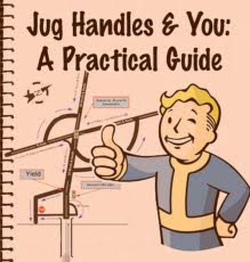
Everyone who drives in New Jersey for the first time and wants to make a left turn has to deal with The loop. In New Jersey it is called a jughandle, a traffic formation that looks as it sounds: you have to turn right to turn left.
After more than a half-century, though, the jughandle — so intertwined with the Garden State that it is also called a “Jersey left” — faces a threat. On Monday, a proposal to ban future jughandles cleared the State Senate’s transportation committee, allowing for a debate and a full vote.
Officials said construction of the state’s hundreds of jughandles dated to the 1940s and grew as part of an effort to keep traffic clusters off main drags. But like the state’s many traffic circles, the jughandle has become a polarizing force.
After more than a half-century, though, the jughandle — so intertwined with the Garden State that it is also called a “Jersey left” — faces a threat. On Monday, a proposal to ban future jughandles cleared the State Senate’s transportation committee, allowing for a debate and a full vote.
Officials said construction of the state’s hundreds of jughandles dated to the 1940s and grew as part of an effort to keep traffic clusters off main drags. But like the state’s many traffic circles, the jughandle has become a polarizing force.
The bill’s author, State Senator James Holzapfel of Toms River, described the minutes-long wait at a jughandle as “my personal hell.” Since 2003, when Mr. Holzapfel was an assemblyman, he has introduced a jughandle bill every two years. Monday was the first time his plan passed in a committee. “I’ve sat through three, four changes of the light before I could even get over the highway,” he said. “You sit there and say, ‘There’s got to be a better way.’ ”
Officials with the State Transportation Department are not so sure, suggesting that the alternatives — dedicated turn lanes or mixed-use lanes — leave drivers vulnerable to backups in active travel lanes, including high-speed lanes.
“We, as a department, have found that the jughandle design does serve a purpose,” said Tim Greeley, a department spokesman.
A spokesman for Gov. Chris Christie did not respond to a message seeking the governor’s position on jughandles.
Some residents have said the greatest shortcoming of the state’s turning policy is its inconsistency. Some stretches include traditional left turns and jughandles in proximity, leaving a left-leaning driver to guess which lane to enter. Mr. Holzapfel noted that roads by the state’s resort towns were particularly problematic to visitors unfamiliar with the convention.
“They go to the intersection, stop, then try to make a left across a three-lane road,” he said.
Mr. Holzapfel said that intersections once plagued with accidents and backups, including some on Routes 1 and 17, had been remedied in recent years with the use of overpasses and other designs that eliminated the need for jughandles. He estimated that jughandles had caused thousands of accidents. If passed, the bill would affect the future construction of jughandles, not those that are already in place.
Officials with the State Transportation Department are not so sure, suggesting that the alternatives — dedicated turn lanes or mixed-use lanes — leave drivers vulnerable to backups in active travel lanes, including high-speed lanes.
“We, as a department, have found that the jughandle design does serve a purpose,” said Tim Greeley, a department spokesman.
A spokesman for Gov. Chris Christie did not respond to a message seeking the governor’s position on jughandles.
Some residents have said the greatest shortcoming of the state’s turning policy is its inconsistency. Some stretches include traditional left turns and jughandles in proximity, leaving a left-leaning driver to guess which lane to enter. Mr. Holzapfel noted that roads by the state’s resort towns were particularly problematic to visitors unfamiliar with the convention.
“They go to the intersection, stop, then try to make a left across a three-lane road,” he said.
Mr. Holzapfel said that intersections once plagued with accidents and backups, including some on Routes 1 and 17, had been remedied in recent years with the use of overpasses and other designs that eliminated the need for jughandles. He estimated that jughandles had caused thousands of accidents. If passed, the bill would affect the future construction of jughandles, not those that are already in place.
 RSS Feed
RSS Feed